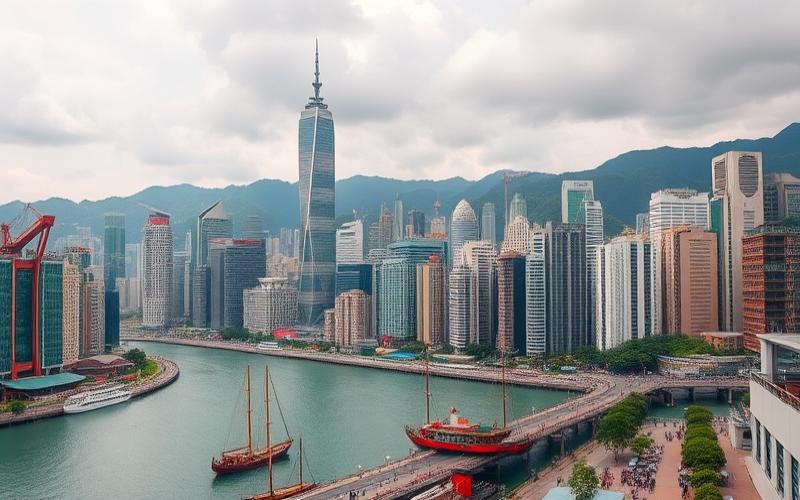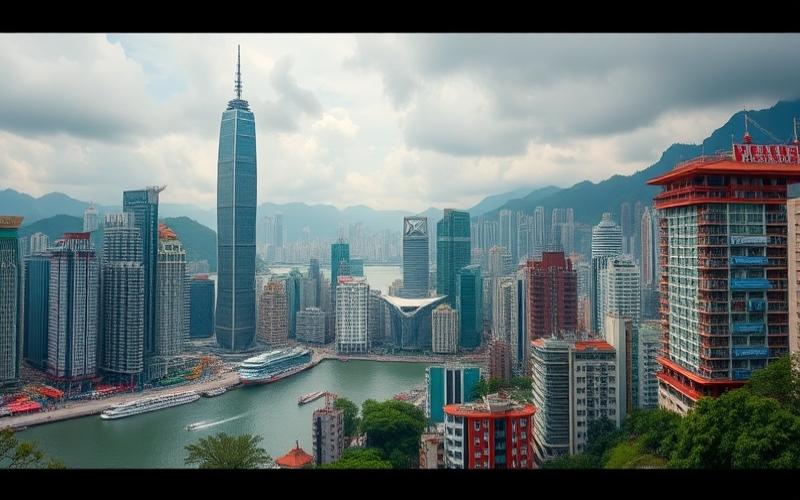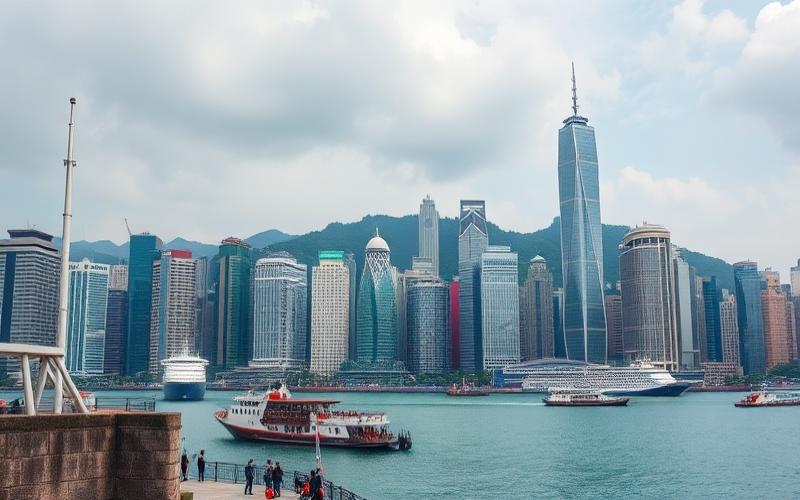
 Published on and written by Cyril Jarnias
Published on and written by Cyril Jarnias
Investing in Parking Spaces in Hong Kong
Investing in parking spaces in Hong Kong represents an often overlooked but potentially lucrative opportunity, given the limited space and urban congestion of this dynamic metropolis.
While residential and commercial real estate prices continue to climb, the parking market offers an attractive investment alternative with promising returns for savvy investors.
This article explores the profitability of these investments, highlighting key factors to consider and current trends that could influence your decision.
Understanding Hong Kong’s Parking Market
Recent Supply and Demand Trends
Hong Kong’s parking market is characterized by strong demand and limited supply, particularly in high-density central districts. On-street parking space occupancy rates average 90%, exceeding 95% in heavily trafficked areas. Between 2020 and 2024, the number of paid on-street spaces increased by approximately 10%, but this growth remains insufficient compared to the steady rise in the vehicle fleet.
| Year | Estimated Number of On-Street Spaces | Average Occupancy Rate |
| 2020 | ~18,000 | ~87% |
| 2024 | ~20,000 | ~90-95% |
Monthly rates for covered residential parking spaces have increased from HKD 1,900-3,150 (2024) to HKD 2,060-3,310 (projected for 2025), representing an average increase of approximately 5%. Open parking lots follow the same trend with similar increases.
Market Influencing Factors
- Extreme Urban Density:
- Hong Kong ranks among the world’s most densely populated cities, limiting available space for creating or expanding parking facilities.
- Real Estate Development:
- Priority given to residential/commercial projects reduces land allocated for traditional parking.
- Systematic integration of smart parking in new real estate developments is rapidly increasing.
- Government Policies:
- Active promotion of connected “smart parking” solutions.
- Maintenance of low regulated rates on public roads, creating imbalance with the private sector.
- Political difficulty in significantly increasing public fees despite inflation (+70% since 1994 while some rates haven’t changed).
Major Challenges for Investors
- Extremely high land costs, making profitability difficult without technological optimization or premium positioning.
- Increased competition between institutional and private investors seeking to secure these scarce assets.
- Regulatory uncertainty:
- Risk of legislative changes aimed at further limiting creation/expansion of traditional parking to encourage public or shared transportation use.
Concrete Examples:
- Potential future increases in specific taxes/charges
- Possible bans in certain ultra-dense central districts
- Dependence on public pricing policies
Observed Opportunities and Profitability
Despite these structural challenges, the sector still offers excellent profitability compared to other real estate assets:
- Current observed annual gross returns: between 2.8% (outlying districts) and 5.2% (high-pressure central areas).
- Sectors with strong potential remain those where additional supply is nearly impossible:
- Central & Western District
- Wan Chai/Causeway Bay
- Kowloon West/Tsim Sha Tsui
The rapid growth of the “smart parking” segment also creates new financial leverage through additional revenue from integrated digital services (smart management, mobile reservations…).
Remember: The Hong Kong market therefore remains attractive but requires dynamic management in response to rapid technological changes and careful monitoring of the local political environment.
Good to Know:
Hong Kong’s parking market is influenced by its high urban density and growing demand for spaces, exacerbated by continuous population and vehicle growth. In recent years, parking space numbers have increased at a slower pace than car registrations, creating a notable imbalance. Districts such as Central and Tsim Sha Tsui are particularly sought after due to their accessibility and commercial/residential facilities. In these areas, annual returns of around 6-8% have been observed for parking investors. However, high real estate costs, coupled with restrictive parking policies aimed at discouraging car use, present significant challenges. Winning investment strategies include targeting areas undergoing real estate development or near key infrastructure, where future parking demand increases are anticipated.
Benefits of Investing in Parking
Main Benefits of Investing in Hong Kong Parking
- Strong Demand and Supply Scarcity:
- The increase in private vehicles (+48% between 2007 and 2017) contrasts with low growth in private parking spaces (+9% over the same period). This tension creates strong structural demand, as high urban density drastically limits adding new spaces.
- Sought-after residential neighborhoods or central commercial areas, where public transport access is less direct, experience near-systematic use of existing parking facilities.
- Profitability and Regular Income Streams:
- Chronic lack of available spaces supports high occupancy rates, generating stable rental income for investors.
- Parking also represents a more accessible entry point to the Hong Kong real estate market: their initial cost is much lower than apartments or offices while offering competitive rental yields.
| Benefit | Detail |
|---|---|
| High Demand | Growing vehicle fleet without proportional increase in available spaces |
| Scarcity | Regulatory limitation on total number of spaces |
| Profitability | High occupancy rates ensuring consistent rental income |
| Entry Barrier | Lower initial investment than traditional residential properties |
- Real Estate Appreciation Potential:
- Ongoing government restrictions on creating new parking artificially limit supply. This not only supports current prices but also favors their appreciation over time with continued urban and economic development.
- Favorable or Unfavorable Impact of Local Regulations:
- Unlike the residential sector subject to high stamp duties and strict mortgage restrictions, these measures don’t apply to parking spaces. This context makes this segment particularly attractive compared directly to conventional housing.
Practical Example:
For some investments under two million HKD, the stamp duty is only symbolic (HKD 100), thus facilitating acquisition for individuals or small investors.
- Potential Tax Incentives:
- While there are currently no massive specific subsidies dedicated to traditional private parking in Hong Kong, certain tax measures like temporary stamp duty reductions make these investments even more advantageous compared to other commercial real estate segments.
Future Influence of Infrastructure and Urban Policies:
- List of positively influencing factors:
- Continued expansion into certain new districts where public transport remains incomplete
- Commercial development requiring more individual motorized access
- Intentional maintenance by local government of overall cap on new creations
- Potentially negatively influencing factors:
- Active promotion by Hong Kong of public transport to limit road congestion
- Potential future capping or reduction of private vehicle fleet if environmental policies are strengthened
Key Takeaway
Parking investment thus offers:
- A tangible investment backed by structural scarcity,
- Regular returns supported by constant need,
- Protection against certain restrictive regulations affecting other Hong Kong real estate sectors,
- Appreciation potential linked to both economic development and urban dynamics themselves.
Good to Know:
Investing in parking in Hong Kong offers several notable advantages, primarily due to high urban density and lack of space ensuring strong demand for parking spaces, which can lead to high profitability and stable income streams for investors. The value of parking-related real estate continues to appreciate due to economic developments and constant urban expansion in the region. Additionally, certain local regulations favor parking investment, and tax incentives or subsidies may be available to support this type of real estate development. The evolution of Hong Kong’s transport infrastructure, while potentially impactful, reinforces the importance of well-located parking spaces, increasing their appeal as strategic investments.
Analyzing Parking Investment Profitability
Main Factors in Hong Kong Parking Investment Profitability:
- Initial Acquisition Cost
- Prices vary significantly by location and quality.
- In 2024, spaces in mid-range residential complexes trade between HKD 520,000 (bulk sale) and HKD 1.2-1.4 million (individual sale).
- In some premium districts or during market peaks, record transactions exceed HKD 6 million per space, although the recent trend is rather downward with several districts falling below the million threshold.
- Average Occupancy Rates
- Rates remain high in residential neighborhoods near transport or border areas.
- Example: housing/space ratio at Sunningdale Garden approaching 10.6 to 1, indicating very limited supply versus demand.
- Rental Rates
Space Type Typical Monthly Rent (2025) Average Residential HKD 2,500 – 2,700 Premium Residential Up to HKD 3,310 Generally:
- Observed net rental yield: between 4.3% (secondary market) and up to approximately 7% on some recent bulk operations.
- Comparison: these yields are significantly higher than standard residential apartments whose gross yields often hover around 2-3%.
- Associated Management Fees
- Moderate compared to classic commercial or residential real estate.
- Include common charges, administrative fees and local taxes. Structural simplicity reduces rental risk beyond occupancy.
- Local Real Estate Regulations
Key Points:
- Government policy now actively limits excessive creation of new private parking to reduce car congestion. Some recent projects impose maximum ratios that can drop to one space for seven or eight new apartments.
- Authorities have also recently increased annual fees and public rate caps to align with the private sector.
Comparison with Other Real Estate Investments
| Investment | Price per m² / ft² | Typical Gross Yield | Value Volatility |
|---|---|---|---|
| Private Parking | Up to HKD 44,444 / ft² | ~4-7% | Medium/High |
| New/Main Housing | HKD 20,000 / ft² | ~2-5% | Medium |
Potential Impact of Government Policies and Urban Trends
The official total number now exceeds 800,000 spaces, with an increase >15,000 over three years thanks particularly to public but also private efforts to partially address the persistent shortage.
However:
- Urban development clearly aims for gradual reduction of the private vehicle fleet through regulatory limitation and incentives favoring public transport.
- Expected continued increase in taxes/fees on long-term parking.
- Growing introduction of smart parking (dynamic pricing), which may affect future rental attractiveness.
Favorable Scenario
– Bulk purchase around floor price (95%); rents driven by low competition; net yield higher than conventional housing (>6%).
– Scarcity maintained by construction restrictions enhancing asset valuation.
Unfavorable Scenario
– Acquisition during speculative peak; general decline linked to regulatory tightening or regional economic slowdown.
– Rapid multiplication of total number via municipal projects/digitalization significantly reducing occupancy rates & rents (-15/20%).
– Yields below opportunity cost; increased difficulty during individual resale if buyer pool restricted.
Good to Know:
Investing in Hong Kong parking can be very advantageous, but several factors must be considered to assess profitability. The initial acquisition cost of a parking space can vary but generally remains more accessible than other real estate types, with alternatives like offices or retail often more expensive. Hong Kong parking occupancy rates are high, typically around 90%, thanks to high urban density and constant parking demand. Rental rates, influenced by location and size, can generate attractive gross returns, sometimes exceeding 4% annually; however, it’s crucial to account for management fees and local regulations, which can represent up to 10% of annual costs. Meanwhile, government urban development and transport policies could impact future demand; for example, increased electric vehicles will potentially require adapted infrastructure. In a favorable scenario, this investment could offer stable and progressive returns, but under unfavorable conditions, such as regulatory tightening or demand decline due to new transport infrastructure, profitability could be compromised.
Case Studies: Successful Hong Kong Parking Investments
Concrete Examples of Successful Hong Kong Parking Investments
| Location | Initial Investment Amount | Resale Price / Final Value | Time to Return on Investment | Approximate Return |
| Kowloon (Luxury Residential) | USD 430,000 (approx. HKD 3.4M) | USD 760,000 (approx. HKD 6M) | 9 months | +76% over 9 months |
| The Peak (Ultra-Chic District) | HKD 10M (approx. EUR 1M) | Absolute Record 2021 | Not disclosed (immediate sale) | Record value per m² |
Key Success Factors of These Investments:
- Strategic Location: Parking spaces located in luxury districts like Kowloon or The Peak reach record prices, due to space scarcity and concentration of wealthy residents.
- Extremely Limited Supply: Many parking spaces are held by developers and rarely come to market. When a space becomes available, demand is so strong that prices skyrocket.
- Restrictive Local Regulations: New constructions often impose very low parking space ratios relative to residential units (sometimes one space for 7 or 8 homes), reinforcing scarcity and value of existing spaces.
- Sustained Demand Despite Economic Slowdown: Private car registrations have increased in recent years, maintaining market pressure.
- Accessibility and Attractiveness: Spaces closest to entrances or elevators, or located on lower levels of multi-story parking facilities, trade at premium prices.
Investor Testimonials and Quotes
“It may seem crazy to spend over USD 430,000 on a parking space, but when you can resell it nine months later for USD 760,000, the investment makes perfect sense.”
— Anonymous Owner, Kowloon
“An acute imbalance between supply and demand explains these records. As soon as a space hits the market, buyers compete to obtain it.”
— Dorothy Chow, JLL Hong Kong
Market Trends and Context
- Ultra-Tight Residential Real Estate Market: Price per square meter for a parking space sometimes far exceeds that of conventional residential real estate.
- Attractive Alternative Investment: For investors seeking portfolio diversification, parking spaces offer a more accessible entry point than apartment purchases, while presenting high capital gain potential.
- Rapid Return on Investment: Studied cases show returns of 50-80% in less than a year in high supply tension situations.
Illustration of Financial Returns Achieved
| Year | Purchase Price (USD) | Resale Price (USD) | Gross Gain | Holding Period | Annualized Return |
| 2018 | 430,000 | 760,000 | 330,000 | 9 months | ≈ 100% |
Impact of Regulation and Demand
Urban policy limits creation of new parking spaces to discourage car use, which boosts value of existing spaces.
Demand remains strong, fueled by growth in private vehicle fleet and supply scarcity, even when the economy slows.
Summary of Success Factors:
- Extreme Supply Scarcity
- Premium Location
- High and Rapid Returns
- Attractiveness for Diversification-Seeking Investors
Note:
Past performance does not guarantee future results. The market remains sensitive to government policies and evolution of the local economic context.
Good to Know:
In Hong Kong, investing in parking has proven highly profitable, as evidenced by successful projects in Central and Kowloon. For example, one investor purchased a space in Central for USD 500,000, achieving full return on investment in just three years through high rents and sustained demand. Another owner acquired a parking facility in Kowloon for USD 300,000, and thanks to rising real estate markets, doubled their investment in five years. These successes are partly due to strict regulations limiting new construction, creating scarcity that fuels demand. Local investors also emphasize the importance of location, as noted by Ms. Chan, a parking space owner, in an interview: “Location is crucial, especially near commercial areas or MTR stations.” Charts show profit margins often exceeding 20%, illustrating the exceptional profitability of these investments.
Disclaimer: The information provided on this website is for informational purposes only and does not constitute financial, legal, or professional advice. We encourage you to consult qualified experts before making any investment, real estate, or expatriation decisions. Although we strive to maintain up-to-date and accurate information, we do not guarantee the completeness, accuracy, or timeliness of the proposed content. As investment and expatriation involve risks, we disclaim any liability for potential losses or damages arising from the use of this site. Your use of this site confirms your acceptance of these terms and your understanding of the associated risks.












































